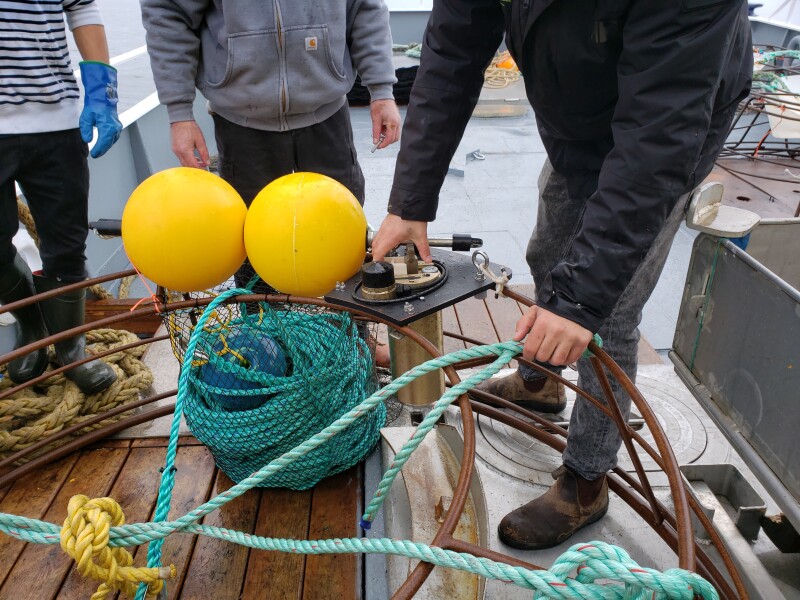The largest deployment of on-demand, or “ropeless” fishing gear in southern New England recently concluded with up to 30 federally permitted lobster and Jonah crab vessels fishing waters closed to traditional trap and vertical-line setups. The collaboration between the National Marine Fisheries Service, its Northeast Fisheries Science Center, and southern New England pot and trap fishermen is an effort to test a potential long-term solution to prevent whale entanglements.
Participating fishermen were allowed 10 trawls each, using different designs of on-demand gear, activated by acoustic signals for retrieval, in federal waters of the South Island Restricted Area and the Massachusetts Restricted Area. Testing ran from Feb. 1 to April 30 under an Exempted Fishing Permit issued to the NOAA Northeast Fisheries Science Center.
“It’s been nice because a couple of years ago fishermen would say ropeless would never work,” Henry Milliken, a supervisory research fishery biologist at the Northeast Fisheries Science Center. “Now they say it will be the technology that keeps them on the water.”
No participating fishermen responded to requests for comment and NMFS refused to release the names of participating fishermen. There have been allegations of harassment and threats levied at fishermen on both the Atlantic and Pacific coasts who have participated in prior on-demand and ropeless tests.
For the southern New England study, on-demand gear was provided to fishermen through the Northeast Fisheries Science Center Gear Library. The library has 245 on-demand gear systems purchased through a combination of federal and private funds with orders already placed for additional gear, Milliken said.
Fishermen in the closed area were provided with both EdgeTech pop-up gear and SMELTS inflatable bag systems by the gear library. The Massachusetts-based EdgeTech ropeless system uses a rectangular cage, similar in appearance to a lobster trap, with a partition in the middle. Rope coiled in one side and the acoustic release on the other, which holds the top of the cage in place. Buoys are mounted on the top, so when the command signal is sent the top float to the surface for, pulling the rope up for retrieval.
The Washington-based SMELTS (Sea Mammal Education Learning Technology Society) Lobster Raft model uses an acoustic release system developed by the Woods Hole Oceanographic Institution which triggers a compress air cylinder to inflate a buoy, which pulls the trap to the surface for retrieval.
For virtual gear marking, fishermen in the closed area use the surface GPS-based EdgeTech Trap Tracker on tablets and smartphones. The science center has encouraged mariners in the area to download the app on the Apple’s App Store or Google Play “to visualize the gear positions and orientations of trawls” and “‘see’ gear within 5 nautical miles of the set.”
The EFP also allows for 100 vessels to test on-demand gear in open waters outside the restricted areas. Both groups of fishermen are allowed to retain their catch and sell their product at market prices. Those testing the experimental gear in open waters are compensated “for providing data on environmental and fishing conditions, operational problems, and timing data,” said Teri Frady, spokesperson for the Northeast Fisheries Science Center.
Vessels in open waters are testing other on-demand systems in addition to the EdgeTech and SMELTS models, Milliken said. These fishermen are also testing other surface GPS virtual gear marking apps.
Those fishing in the closed areas “have experience using this gear and have demonstrated success,” Frady said. The other 100 vessels are using hybrid trawls with a ropeless system deployed at just one end and have “varying levels of experience” with some fishermen testing the gear on the water for the first time.
According to the Northeast Fisheries Science Center, research goals include: demonstrating success retrieving of multi-trap trawls using acoustic releases, improving operational efficiency, accuracy of data collected, data sharing, and providing feedback to gear manufacturers to improve the performance of on-demand and virtual gear marking systems under commercial fishing conditions.
The science center has applied for another exempted permit to become effective when with current one expires in August, Frady said.
Meanwhile Maine state legislators are proposing to spend $1 million annually to help lobstermen test new fishing technology including pop-up gear for retrieving lobster traps.
The “Lobster Innovation Fund” would fund $2 million over the next two years to provide stipends for lobstermen testing new gear. That proposal has won support from Maine state officials and the Maine Lobstermen’s Association, who see it as one more option toward long-term resolution of whale conflict issues.







